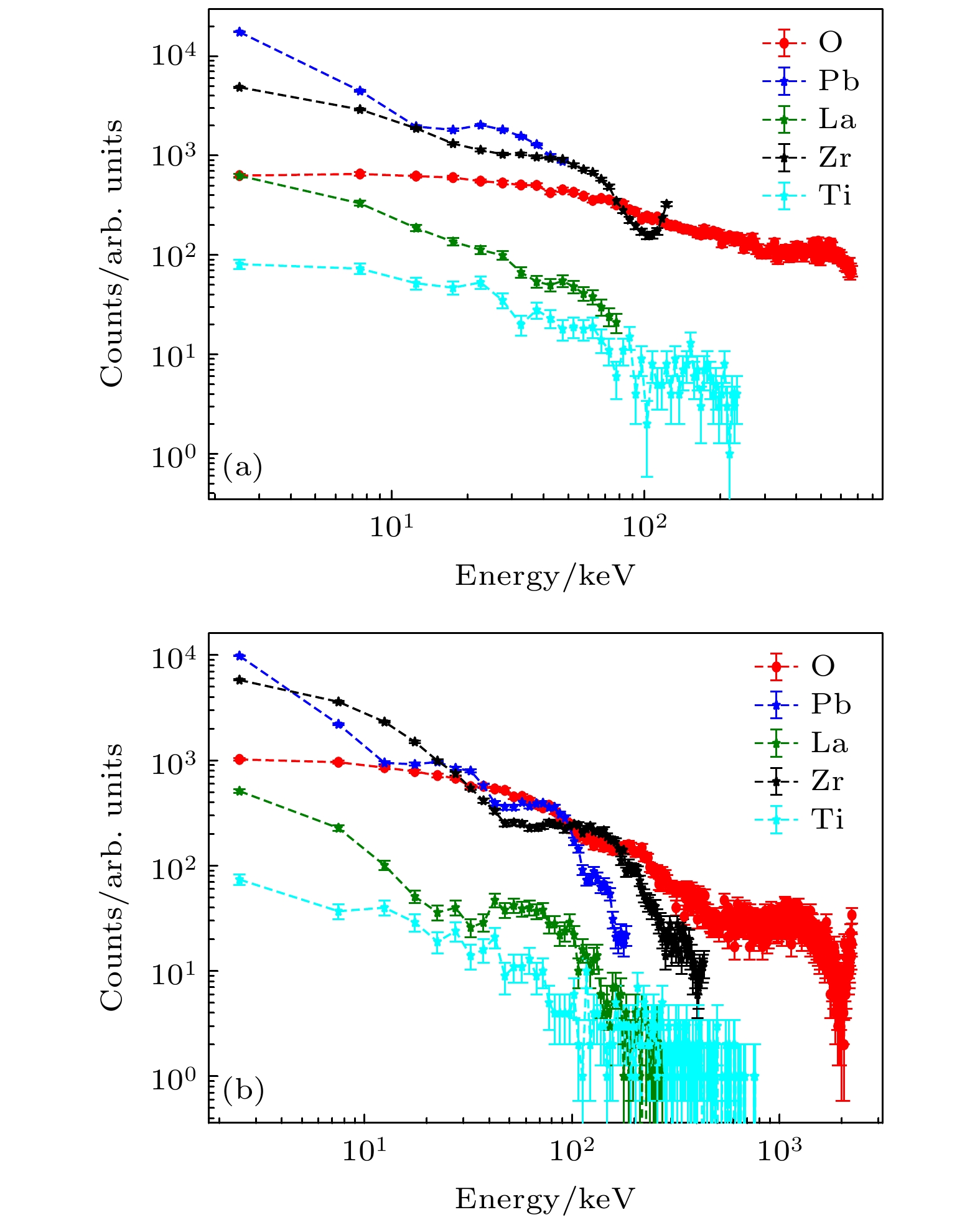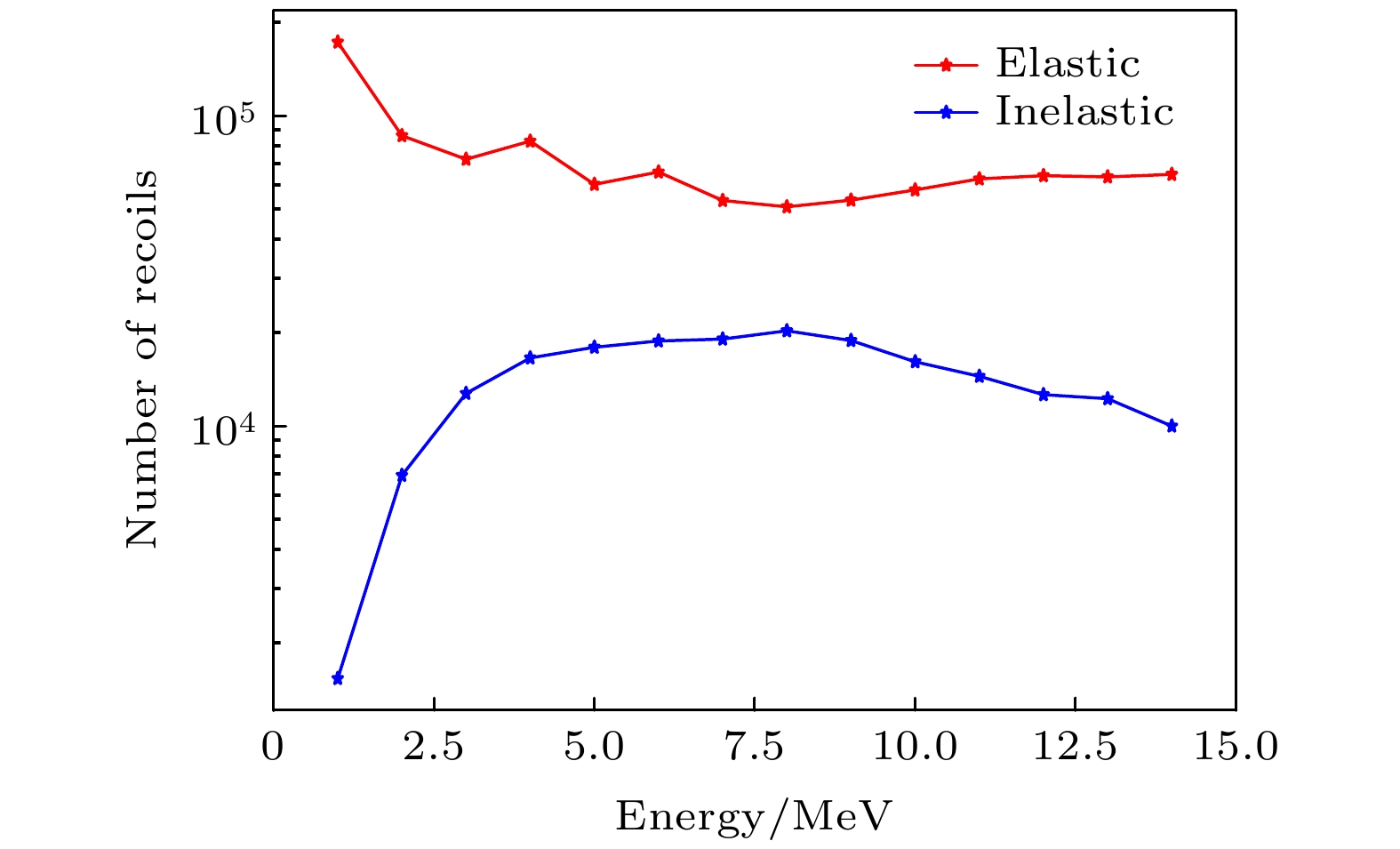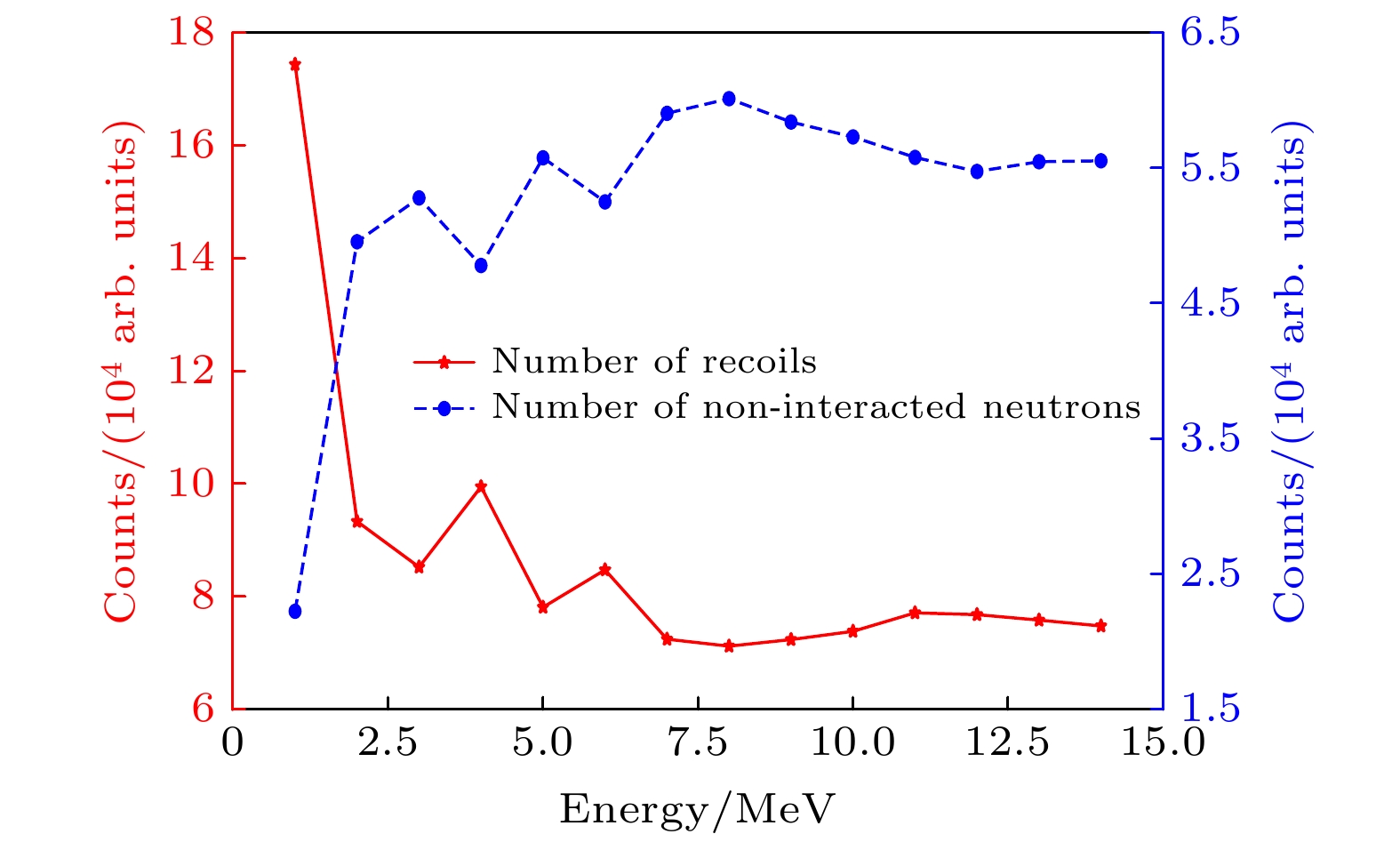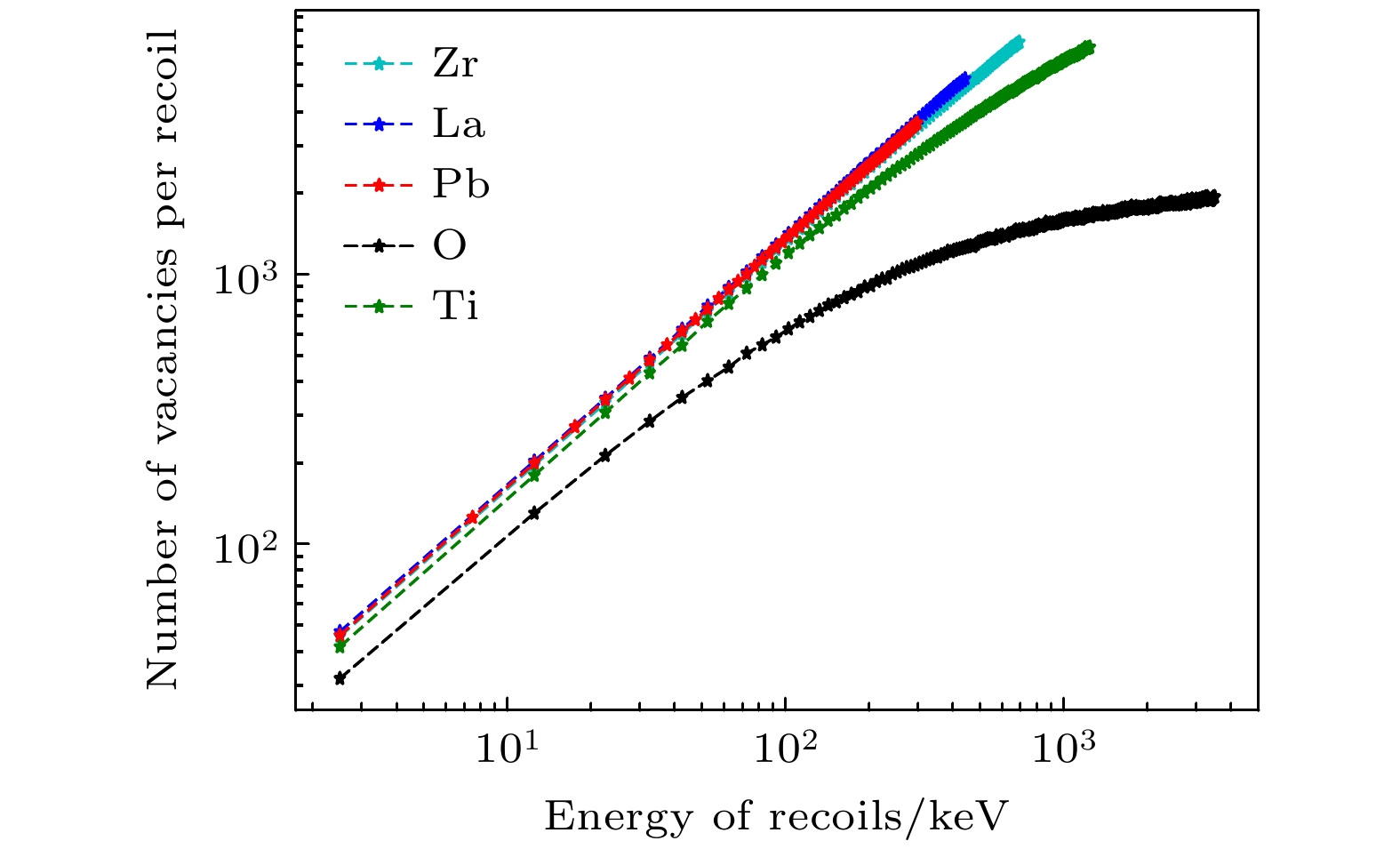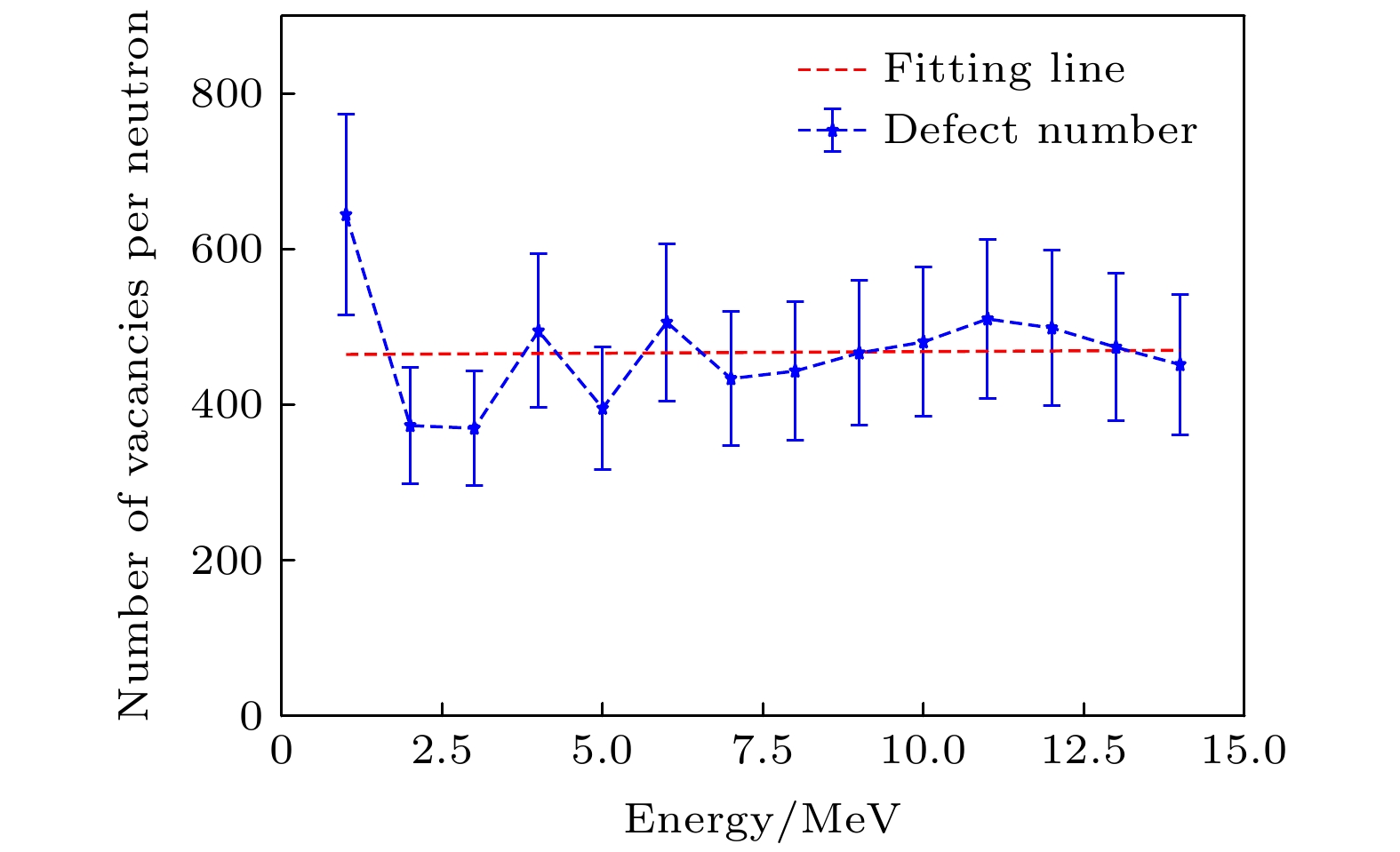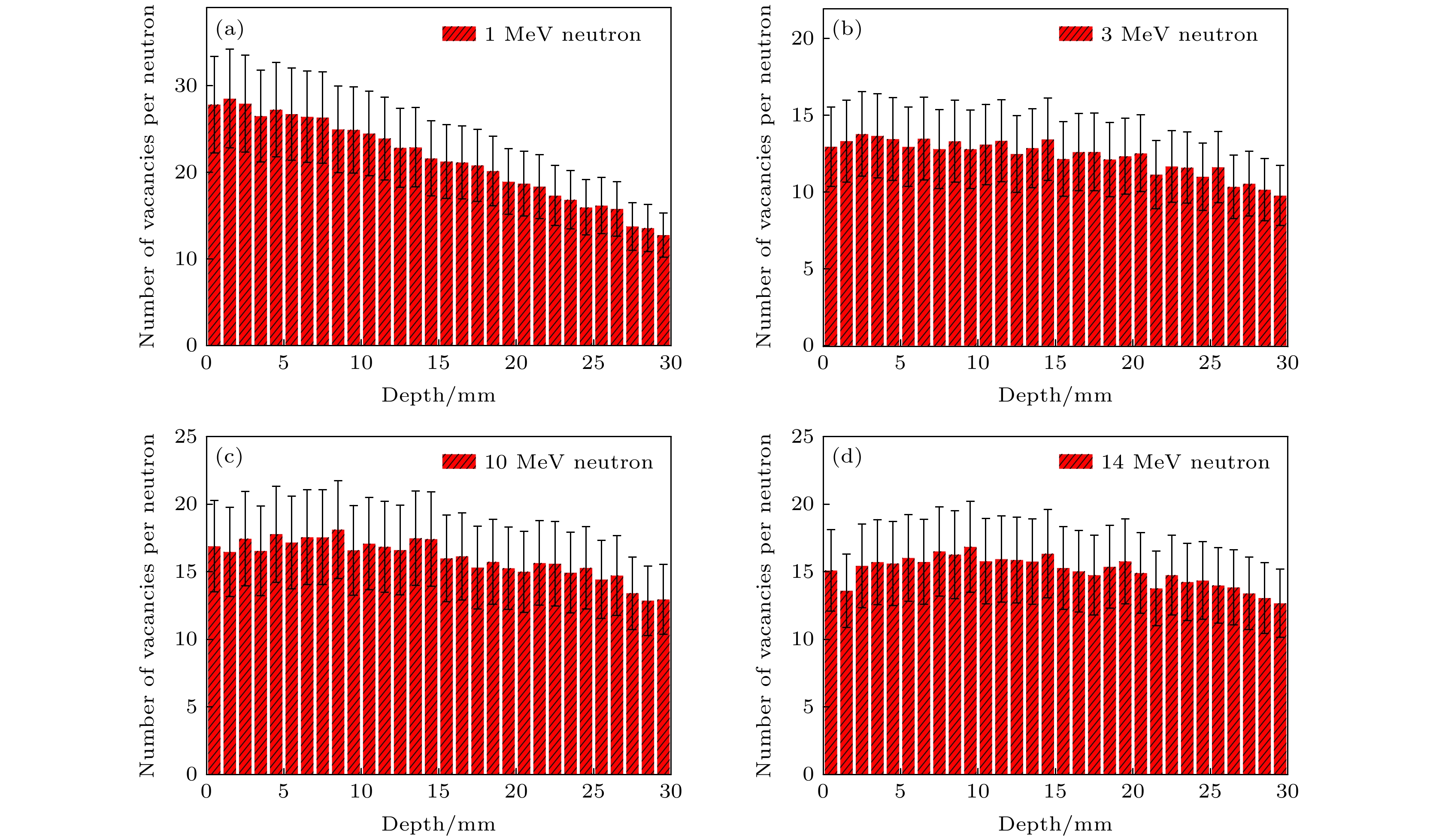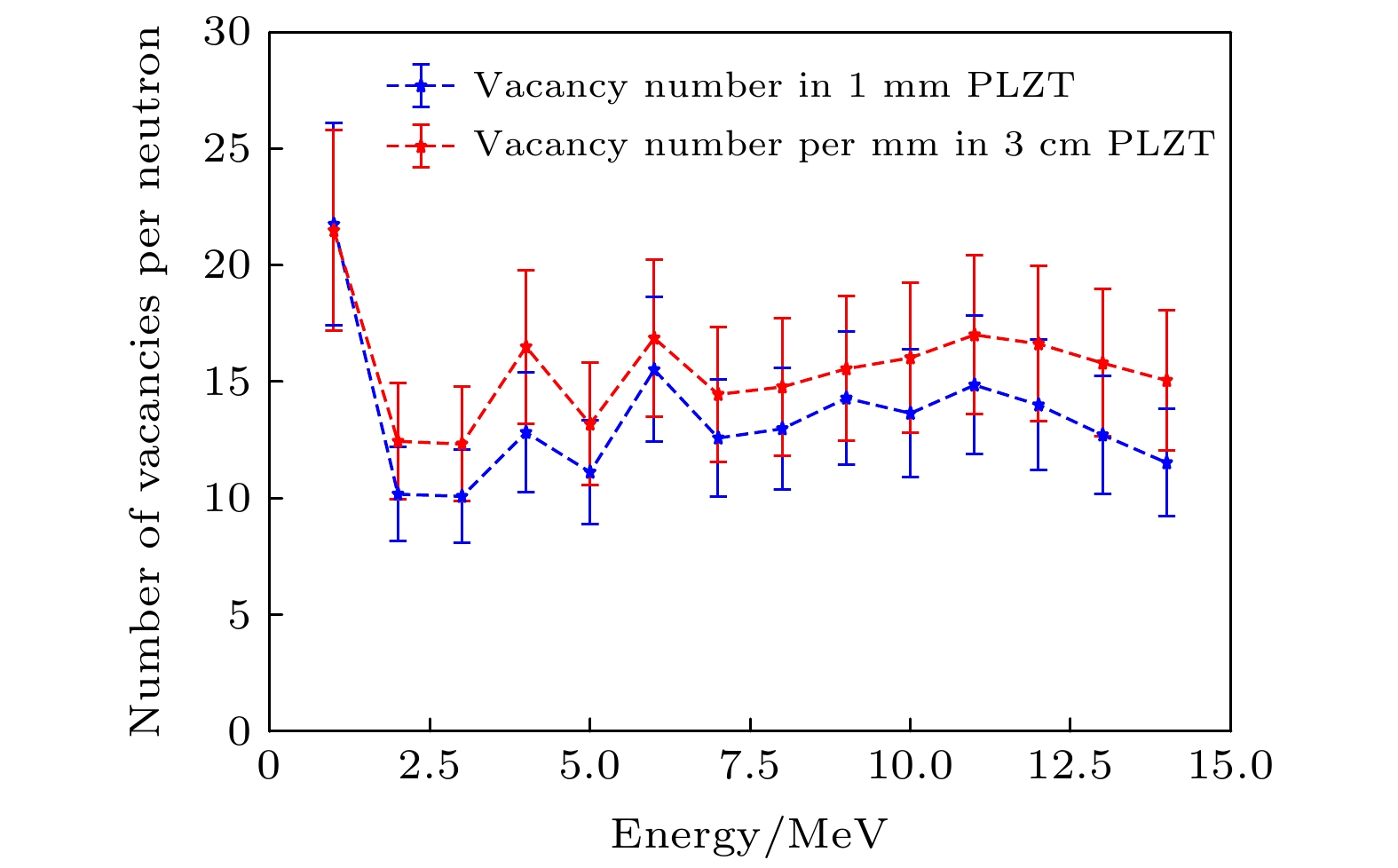-
Lead lanthanum zirconate titanate (PLZT) has a broad application prospect for energy storage devices with high energy density, since it possesses excellent dielectric and energy storage properties. To investigate the irradiation damage to the PLZT induced by neutrons with different energy, the primary energetic recoil spectra of each kind of element are first extracted from the transportation simulations of neutrons with energy ranging from 1 to 14 MeV, respectively. Then, the displacement damages (including vacancies and interstitial atoms) induced by each type of recoil with different energy are simulated based on the binary collision approximation method. Finally the number of defects in PLZT produced by neutrons with an energy range from 1 to 14 MeV is calculated based on the recoil energy spectra and the defect number produced by the recoils. The results show that the number of defects produced in the PLZT material with a thickness of 3 cm is approximately independent of the neutron energy for the fast neutrons with energy in a range from 1 to 14 MeV, even though the primary recoil energy spectra from neutrons with different energy are completely different. The average number of defects produced in 3-cm-thick PLZT is about 460 ± 120 vacancies/neutrons. For neutrons with energy ranging from 1 to 14 MeV, the produced defect concentration in PLZT decreases slightly with the depth increasing within a thickness of 3 cm. The difference in defect concentration in this 3 cm is in a range of 50%. This decrease is caused mainly by the fact that some of neutrons are back-scattered during transport. The average defect concentration produced by neutron irradiation in the PLZT with a thickness of 3 cm is slightly(~20%) higher than that in the PLZT with a thickness of 1 mm. The reason for the higher defect concentration in a thicker (3 cm) PLZT can be attributed to the following facts: (i) the (n, 2n) reactions between neutron and material can make the number of neutrons increase during transport; (ii) the scattering can make the path of neutron longer; (iii) the inelastic scattering can lead to a smallnumber of moderated neutrons, which have a slightly larger interaction cross section with materials. This indicates the damage produced in thick PLZT is quite complicated and closely related to the process of neutron transport. This work presents a method of calculating the displacement damage of neutrons in materials, and the simulation results can provide guidance for studying the neutron irradiation effects of PLZT-based electronic devices.
-
Keywords:
- lead lanthanum zirconate titanate /
- Monte Carlo simulations /
- neutron radiation damage /
- concentration of defects
[1] 谢飞, 臧航, 刘方, 何欢, 廖文龙, 黄煜 2020 物理学报 69 192401
 Google Scholar
Google Scholar
Xie F, Zang H, Liu F, He H, Liao W L, Huang Y 2020 Acta Phys. Sin. 69 192401
 Google Scholar
Google Scholar
[2] Hazdra P, Záhlava V, Vobecký J 2014 Nucl. Instrum. Methods Phys. Res., Sect. B 327 124
 Google Scholar
Google Scholar
[3] Sharma R K, Hazdra P, Popelka S 2015 IEEE Trans. Nucl. Sci. 62 534
 Google Scholar
Google Scholar
[4] Rauls M B, Dong W, Huber J E, Lynch C S 2011 Acta Mater. 59 2713
 Google Scholar
Google Scholar
[5] Kumar A, Prasad V V B, Raju K C J, James A R 2016 J. Alloys Compd. 654 95
 Google Scholar
Google Scholar
[6] He H, Tan X 2007 J. Am. Ceram. Soc. 90 2090
 Google Scholar
Google Scholar
[7] Hao X, Zhai J, Kong L B, Xu Z 2014 Prog. Mater. Sci. 63 1
 Google Scholar
Google Scholar
[8] Haertling G H, Land C E 1971 J. Am. Ceram. Soc. 54 1
[9] Sternberg A, Krumina A, Sprogis A, Rubulis A, Grinvalds G, Shebanov L, Weber H W, Klima H, Schwabl H, Dindun S, Ulmanis U 1992 Ferroelectrics 126 233
 Google Scholar
Google Scholar
[10] Bittner R, Humer K, Weber H W, Cakare L, Sternberg A, Lesnyh D. A, Kulikov D V, Trushin Y V 2002 Integr. Ferroelectr. 47 143
 Google Scholar
Google Scholar
[11] Kulikov D V, Trushin Y V, Kharlamov V S, Bittner R, Schmidt A A 2000 Proc. SPIE 4348 264
[12] Sternberg A, Kundzins K, Zauls V, Aulika I, Akare L, Bittner R, Weber H, Humer K, Lesnyh D, Kulikov D 2004 J. Eur. Ceram. Soc. 24 1653
 Google Scholar
Google Scholar
[13] Nordlund K, Zinkle S J, Sand A E, Granberg F, Averback R S, Stoller R E, Suzudo T, Malerba L, Banhart F, Weber W J, Willaime F, Dudarev S L, Simeone D 2018 J. Nucl. Mater. 512 450
 Google Scholar
Google Scholar
[14] Nordlund K 2019 J. Nucl. Mater. 520 273
 Google Scholar
Google Scholar
[15] Robinson M T, Torrens I M 1974 Phys. Rev. B 9 5008
 Google Scholar
Google Scholar
[16] Zhang S, Nordlund K, Djurabekova F, Granberg F, Zhang Y, Wang T S 2017 Mater. Res. Lett. 5 433
 Google Scholar
Google Scholar
[17] Djurabekova F G, Pugacheva T S, Umarov F F, Yugay S V 2000 International Conference on Ion Implantation Technology Proceedings. Ion Implantation Technology-2000 (Cat. No. 00EX432), 17–22 Sept. 2000 228
[18] Zhang S, Wang B W, Zhang L M, Liu N, Wang T S, Duan B H, Xu X G 2021 J. Phys. D:Appl. Phys. 54 245104
 Google Scholar
Google Scholar
[19] Zhang S, Nordlund K, Djurabekova F, Zhang Y, Velisa G, Wang T S 2016 Phys. Rev. E 94 043319
 Google Scholar
Google Scholar
[20] Zhang S, Pakarinen O H, Backholm M, Djurabekova F, Nordlund K, Keinonen J, Wang T S 2017 J. Phys.: Condens. Matter. 30 015403
[21] Bukonte L, Djurabekova F, Samela J, Nordlund K, Norris S A, Aziz M J 2013 Nucl. Instrum. Methods Phys. Res., Sect. B 297 23
 Google Scholar
Google Scholar
[22] Klaver T P C, Zhang S, Nordlund K 2017 J. Nucl. Mater. 492 113
 Google Scholar
Google Scholar
[23] Agostinelli S, Allison J, Amako K, et al. 2003 Nucl. Instrum. Methods Phys. Res. Sect. A 506 250
 Google Scholar
Google Scholar
[24] Allison J, Amako K, Apostolakis J, et al. 2016 Nucl. Instrum. Methods Phys. Res., Sect. A 835 186
 Google Scholar
Google Scholar
[25] Allison J, Amako K, Apostolakis J, et al. 2006 IEEE Trans. Nucl. Sci. 53 270
 Google Scholar
Google Scholar
[26] Nuclear Energy Agency http://www.oecd-nea.org/dbdata/jeff/jeff33/
[27] Mendoza E, Cano-Ott D, Koi T, Guerrero C 2014 IEEE Trans. Nucl. Sci. 61 2357
 Google Scholar
Google Scholar
[28] J. F. Ziegler, J. P. Biersack, Littmark U 1985 The Stopping and Range of Ions in Matter (Pergamon, New York: Pergamon Press)
[29] Ziegler J F http://www.srim.org/
[30] Chadwick M B, Herman M, Obložinský P, et al. 2011 Nucl. Data Sheets 112 2887
 Google Scholar
Google Scholar
-
图 4 1—14 MeV中子辐照3 cm厚PLZT材料产生的反冲原子数目(对应左侧Y轴的红色点线)和未与材料发生作用的中子数目(对应右侧Y轴的蓝色点线)
Figure 4. Number of recoils (corresponding to the red dotted line and the left Y-axis) and the number of neutrons without interaction(corresponding to the blue dotted line and the right Y-axis) during irradiation of neutrons with energies from 1 to 14 MeVin PLZT with a thickness of 3 cm.
-
[1] 谢飞, 臧航, 刘方, 何欢, 廖文龙, 黄煜 2020 物理学报 69 192401
 Google Scholar
Google Scholar
Xie F, Zang H, Liu F, He H, Liao W L, Huang Y 2020 Acta Phys. Sin. 69 192401
 Google Scholar
Google Scholar
[2] Hazdra P, Záhlava V, Vobecký J 2014 Nucl. Instrum. Methods Phys. Res., Sect. B 327 124
 Google Scholar
Google Scholar
[3] Sharma R K, Hazdra P, Popelka S 2015 IEEE Trans. Nucl. Sci. 62 534
 Google Scholar
Google Scholar
[4] Rauls M B, Dong W, Huber J E, Lynch C S 2011 Acta Mater. 59 2713
 Google Scholar
Google Scholar
[5] Kumar A, Prasad V V B, Raju K C J, James A R 2016 J. Alloys Compd. 654 95
 Google Scholar
Google Scholar
[6] He H, Tan X 2007 J. Am. Ceram. Soc. 90 2090
 Google Scholar
Google Scholar
[7] Hao X, Zhai J, Kong L B, Xu Z 2014 Prog. Mater. Sci. 63 1
 Google Scholar
Google Scholar
[8] Haertling G H, Land C E 1971 J. Am. Ceram. Soc. 54 1
[9] Sternberg A, Krumina A, Sprogis A, Rubulis A, Grinvalds G, Shebanov L, Weber H W, Klima H, Schwabl H, Dindun S, Ulmanis U 1992 Ferroelectrics 126 233
 Google Scholar
Google Scholar
[10] Bittner R, Humer K, Weber H W, Cakare L, Sternberg A, Lesnyh D. A, Kulikov D V, Trushin Y V 2002 Integr. Ferroelectr. 47 143
 Google Scholar
Google Scholar
[11] Kulikov D V, Trushin Y V, Kharlamov V S, Bittner R, Schmidt A A 2000 Proc. SPIE 4348 264
[12] Sternberg A, Kundzins K, Zauls V, Aulika I, Akare L, Bittner R, Weber H, Humer K, Lesnyh D, Kulikov D 2004 J. Eur. Ceram. Soc. 24 1653
 Google Scholar
Google Scholar
[13] Nordlund K, Zinkle S J, Sand A E, Granberg F, Averback R S, Stoller R E, Suzudo T, Malerba L, Banhart F, Weber W J, Willaime F, Dudarev S L, Simeone D 2018 J. Nucl. Mater. 512 450
 Google Scholar
Google Scholar
[14] Nordlund K 2019 J. Nucl. Mater. 520 273
 Google Scholar
Google Scholar
[15] Robinson M T, Torrens I M 1974 Phys. Rev. B 9 5008
 Google Scholar
Google Scholar
[16] Zhang S, Nordlund K, Djurabekova F, Granberg F, Zhang Y, Wang T S 2017 Mater. Res. Lett. 5 433
 Google Scholar
Google Scholar
[17] Djurabekova F G, Pugacheva T S, Umarov F F, Yugay S V 2000 International Conference on Ion Implantation Technology Proceedings. Ion Implantation Technology-2000 (Cat. No. 00EX432), 17–22 Sept. 2000 228
[18] Zhang S, Wang B W, Zhang L M, Liu N, Wang T S, Duan B H, Xu X G 2021 J. Phys. D:Appl. Phys. 54 245104
 Google Scholar
Google Scholar
[19] Zhang S, Nordlund K, Djurabekova F, Zhang Y, Velisa G, Wang T S 2016 Phys. Rev. E 94 043319
 Google Scholar
Google Scholar
[20] Zhang S, Pakarinen O H, Backholm M, Djurabekova F, Nordlund K, Keinonen J, Wang T S 2017 J. Phys.: Condens. Matter. 30 015403
[21] Bukonte L, Djurabekova F, Samela J, Nordlund K, Norris S A, Aziz M J 2013 Nucl. Instrum. Methods Phys. Res., Sect. B 297 23
 Google Scholar
Google Scholar
[22] Klaver T P C, Zhang S, Nordlund K 2017 J. Nucl. Mater. 492 113
 Google Scholar
Google Scholar
[23] Agostinelli S, Allison J, Amako K, et al. 2003 Nucl. Instrum. Methods Phys. Res. Sect. A 506 250
 Google Scholar
Google Scholar
[24] Allison J, Amako K, Apostolakis J, et al. 2016 Nucl. Instrum. Methods Phys. Res., Sect. A 835 186
 Google Scholar
Google Scholar
[25] Allison J, Amako K, Apostolakis J, et al. 2006 IEEE Trans. Nucl. Sci. 53 270
 Google Scholar
Google Scholar
[26] Nuclear Energy Agency http://www.oecd-nea.org/dbdata/jeff/jeff33/
[27] Mendoza E, Cano-Ott D, Koi T, Guerrero C 2014 IEEE Trans. Nucl. Sci. 61 2357
 Google Scholar
Google Scholar
[28] J. F. Ziegler, J. P. Biersack, Littmark U 1985 The Stopping and Range of Ions in Matter (Pergamon, New York: Pergamon Press)
[29] Ziegler J F http://www.srim.org/
[30] Chadwick M B, Herman M, Obložinský P, et al. 2011 Nucl. Data Sheets 112 2887
 Google Scholar
Google Scholar
Catalog
Metrics
- Abstract views: 6795
- PDF Downloads: 107
- Cited By: 0















 DownLoad:
DownLoad:
